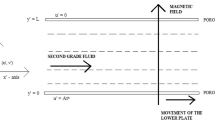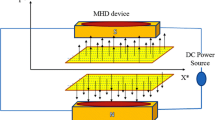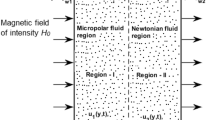Abstract
The magnetohydrodynamic (MHD) flow of a third grade fluid through a rectangular channel, considering the effect of aspect ratio, has been investigated. The flow considered is steady, laminar, incompressible and hydro-dynamically fully developed. The equation, describing the flow, is a highly non-linear partial differential equation (PDE) with remote possibility of having an exact solution and even numerical solution also is very difficult to obtain. A combination of the homotopy perturbation method (HPM) and integral method (IM) has been employed to solve the non-linear PDE which is scarce in open literature. The results of the present study are compared with the results obtained by the least square method (LSM) of the MHD third grade fluid flow through a rectangular channel, without the effect of aspect ratio and are found to be in close agreement. The results indicate that the flow field is significantly affected by the aspect ratio which should be considered for practical applications. In all the available literatures of the third grade fluid flow, the aspect ratio effect is neglected and this simplifying assumption reduces the highly complicated non-linear PDE to a non-linear ordinary differential equation (ODE). The novelty of the subject work lies in the inclusion of the effects of aspect ratio in the governing equation describing the flow of a third grade fluid through a channel and solving this by a combined analytical method (HPM and IM). Further, the effects of the Hartmann number and non-Newtonian third grade fluid parameter on the flow filed are discussed.






Similar content being viewed by others
Abbreviations
- A :
-
third grade fluid parameter,
- A 1, A 2, A 3 :
-
kinematic tensors
- a 0, a 1, b 0, b 1 :
-
Constants
- As :
-
aspect ratio of the channel,
- B :
-
applied magnetic field
- C :
-
constant
- F,G :
-
functions
- Ha :
-
Hartmann number,
- J :
-
current density respectively
- L 1, L 2 :
-
half depth and half width of the channel respectively
- N :
-
non-dimensional pressure gradient,
- R :
-
Residual
- U :
-
average velocity through the channel
- V * :
-
velocity vector
- c 1, c 2 :
-
constants
- f :
-
body force per unit volume
- p :
-
dimensional static pressure,
- u :
-
dimensional axial velocity
- v :
-
dimensionless coordinate in the axial direction
- y :
-
dimensionless coordinate in vertical direction
- z :
-
dimensionless coordinate in the lateral direction
- q :
-
an embedding parameter
- p * :
-
dimensional pressure
- u * :
-
dimensional axial velocity
- y * :
-
dimensional coordinate in the vertical direction
- z * :
-
dimensional coordinate in the lateral direction
- q 0 , q 1 :
-
embedding parameter
- u 0 :
-
0th order solution for the velocity
- u 1 :
-
1st order solution for the velocity
- ρ:
-
density of the fluid,
- τ:
-
stress tensor
- σ:
-
electrical conductivity
- μ:
-
dynamic viscosity the fluid,
- α1, α2, β1, β2, β3 :
-
material constants of the third grade fluid
References
Kundu B, Simlandi S and Das P K 2011 Analytical techniques for analysis of fully developed laminar flow through rectangular channels. Heat Mass Transf. 47(10): 1289–1299
Tso C P, Sheeela-Francisca J and Hung Y M 2010 Viscous dissipation effects of power-law fluid flow within parallel plates with constant heat fluxes. J. Non-Newtonian Fluid Mech. 165(6): 625–630
Siddiqui A M, Zeb A, Ghori, Q K and Benharbit A M 2008 Homotopy perturbation method for heat transfer flow of a third grade fluid between parallel plates. Chaos Solitons Fract. 36(1): 182–192
Danish M, Kumar S and Kumar S 2012 Exact analytical solutions for the Poiseuille and Couette-Poiseuille flow of third grade fluid between parallel plates. Commun.Nonlinear Sci. Numer. Simul. 17(3): 1089–1097
Hsiao K L 2011 MHD mixed convection for visco-elastic fluid past a porous wedge. Int. J. Non-Linear Mech. 46(1): 1–8
Siddheshwar P G and Mahabaleswar U S 2005 Effects of radiation and heat source on MHD flow of a visco-elastic liquid and heat transfer over a stretching sheet. Int. J. Non-linear Mech. 40 (6): 807–820
Chen C H 2008 Effetcs of magnetic field and suction/injection on convection heat transfer on non-Newtonian power-law fluids past a power-law stretched sheet with surface heat flux. Int. J. Therm. Sci. 47(7):954–961
Wang L, Jian Y, Liu Q, Li F and Chang L 2016 Electromagnetohydrodynamic flow and heat transfer of third grade fluids between two micro-parallel plates. Colloids Surf. A: Physicochem. Eng. Asp. 494(5): 87–94
He J H 2006 Homotopy perturbation method for solving boundary value problems. Phys. Lett. A. 350(1–2): 87–88
He J H 2005 Application of homotopy perturbation method to nonlinear wave equations. Chaos Solitons Fract. 26(3): 695–700
Bera P K and Sil T 2012 Homotopy perturbation method in quantum mechanical problems, Appl. Math. Comput. 219(6): 3272–3278
Elsayed A F 2013 Comparison between variational method and Homotopy perturbation method for thermal diffusion and diffusion thermo effects of thixotropic fluid through biological tissues with laser radiation existence. Appl. Math. Model. 37(6): 3660–3673
Yun Y and Temuer C 2015 Application of the homotopy perturbation method for the large deglection problem of a circular plate. Appl. Math. Model. 39(3–4):1308–1316
Golbabai A and Javidi A 2007 Application of homotopy perturbation method for solving eight-order boundary value problems. Appl. Math.Comput. 191(2): 334–346
Hatami M and Ganji D D 2013 Heat transfer and flow analysis for SA-TiO2 non-Newtonian nano fluid passing through the porous media between two coaxial cylinders. J. Mol. Liq. 188(12): 155–161
Hatami M, Sheikholeslami M and Ganji D D 2014 Laminar flow and heat transfer of nanofluid between contracting and rotating disks by least square method. Powder Technol. 253(2):769–779
Khan M, Munawar S, and Abbasbandy S 2010 Steady flow and heat transfer of a Sisko fluid in annular pipe. Int. J. Heat Mass Trans. 53(7–8):1290–1297
Acknowledgements
The authors are thankful to the reviewers for their valuable comments and suggestions which have improved the paper.
Author information
Authors and Affiliations
Corresponding author
Rights and permissions
About this article
Cite this article
CHAUDHURI, S., SAHOO, S. Effect of the aspect ratio on the flow characteristics of magnetohydrodynamic (MHD) third grade fluid flow through a rectangular channel. Sādhanā 43, 106 (2018). https://doi.org/10.1007/s12046-018-0855-5
Received:
Revised:
Accepted:
Published:
DOI: https://doi.org/10.1007/s12046-018-0855-5




